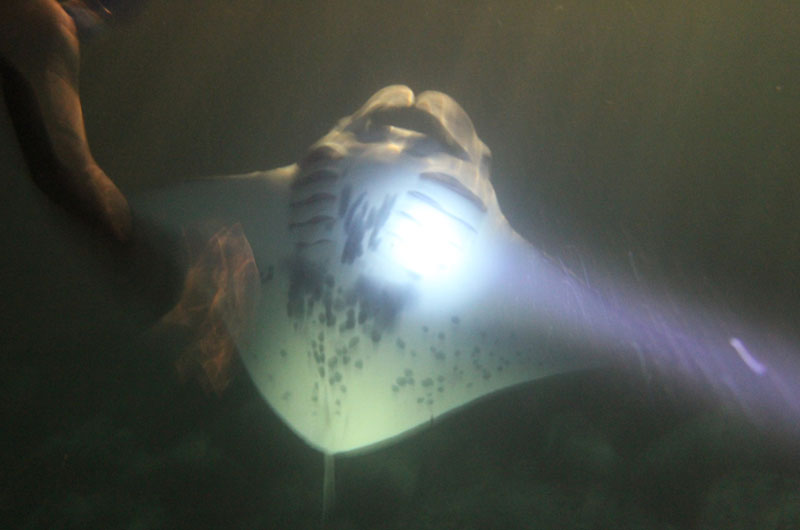
At 8:15 we’re driving down Ali’i dr. headed for Keauhou bay. The sun’s been down for two hours, there’s no moon, the ocean is just an inky blackness beyond the guardrail. We arrive at the Sheraton Keauhou Bay, park the car, and proceed up to the ocean overlook attached to the outdoor lounge. Here at Keauhou bay they shine bright lights into the coastal waters at night. These lights attract zooplankton in large numbers and when that happens plankton feeders soon follow. One of the largest fish in the sea visits this place regularly. This is the domain of the Manta Ray, and we have come to swim with them.
Manta Rays are massive creatures that can measure up to 20 feet from wingtip to wingtip. These huge animals are gentle, intelligent, and not dangerous to humans. Like Whale Sharks, Mantas are plankton feeders. They swim with wide-open mouths, collecting plankton on their gills. The gills line the inner wall of its mouth, and as the animal flips around you can often see them through the gill slits on its underside. Each Manta has a different pattern of black spots on its belly which can be used to identify the individual. The Hawaiian population is all recorded at mantapacific.org.
We arrive at the overlook where a small crowd has gathered. There are 3 midsized manta rays spiraling around in the bright waters illumanted by the lights. These lights often attract the rays but there’s never any guarantee that they’ll be there, so before entering the water make sure you confirm that they’re present.
After returning to the car and changing into snorkel gear we walk back to the shoreline. Many people do the manta ray night dive at the Sheraton because it’s such a unique experience, but most people pay $100+ to be taken by boat on a guided tour. Sure, that’s great if you’ve got the money and prefer to have things done for you, but if you’re adventurous you can do this dive from shore and it won’t cost you a dime.
This is not for beginner snorkelers. Anyone planning to enter from shore should be comfortable in the ocean and understand the dangers of entering the ocean from a rocky shoreline at night. Like many things in Hawaii, this can be dangerous if you’re clueless, but if you’re intelligent and patient you shouldn’t have problems.
The ocean entry is 100 yards up the coast from the lamp-lit bay. It’s accessed by a footpath from the parking lot and is fairly easy to find. You’ll see the rocky coastline and a concrete slab that goes into the water. Put on your fins and mask, make sure your dive light is working, and jump in from one of the higher rocks. You’ll jump directly into deep water, so be prepared. If there are waves you may need to wait and time your entry between them. There are many urchins here, so don’t reach for the rocks unless you can see your hands. When you return you’ll be able to see them and find a safe path out, but for now it’s best to get away from the rocks.
After entering the ocean we swim the 100 yards to the bay through the dark water, which can certainly be a little unnerving, but when you finally see the light through the water and notice the huge shapes gliding through it, the contrast makes the experience that much better.
Before I know it the mantas are all around us, twirlng and sliding past just inches away. They have a have a habit of swimming straight for you and then turning away at the last possible second. It’s best not to touch them. They have a protective coating of mucus that covers their bodies and protects against infection, and touching them rubs this coating off. Mantas that have been touched often will develop pink sores on the affected areas. Knowing this one can still understand how tempting it is to grab hold for a free ride when the animal slides right past your face, just inches from your nose.
The depth here is around 15 feet. Because the area is frequented by many divers and tours it’s likely that you won’t be the only people there. The overlook and lounge are right above the bay, so be prepared to have spectators as well.
Diving with manta rays is an unforgettable experience. This is completely different from reef snorkeling. Here you’re in the water with an animal six times your size. Sitting in their midst is awe inspiring as their massive bodies frolic about as they feed.
On my first manta ray dive I swam with them for about an hour before they receeded into the blackness and ever since then I’ve been addicted. I’ve been back dozens of times. This is one of my favorite dives on the island because it’s fairly easy (it’s all at the surface and there are no crazy currents or anything) and the payoff is huge.
A good dive light is crucial for this dive. The 100 yard swim along the coast is impossible without one. Night dives are inherently more dangerous than their daytime counterparts, but with a good light and some intelligence you can complete this dive safely and easily.
Shore diving with mantas is a unique Hawaiian experience that many people pay a lot of money for. This dive is advanced, but completely free when you enter from the coast. If you have the cojones to make the swim in the dark you’ll be rewarded with an experience you’ll remember forever.
